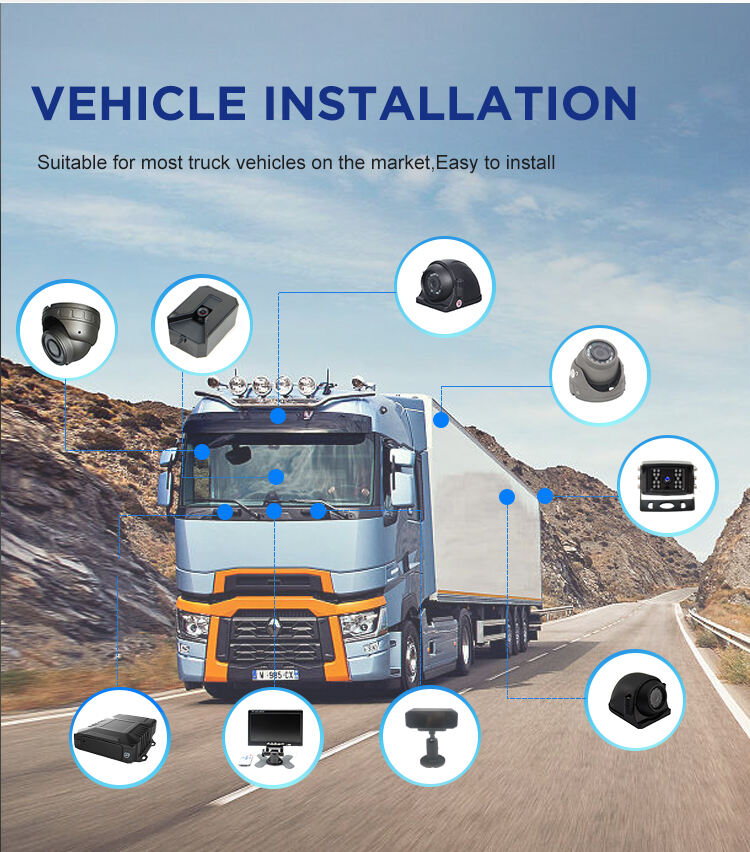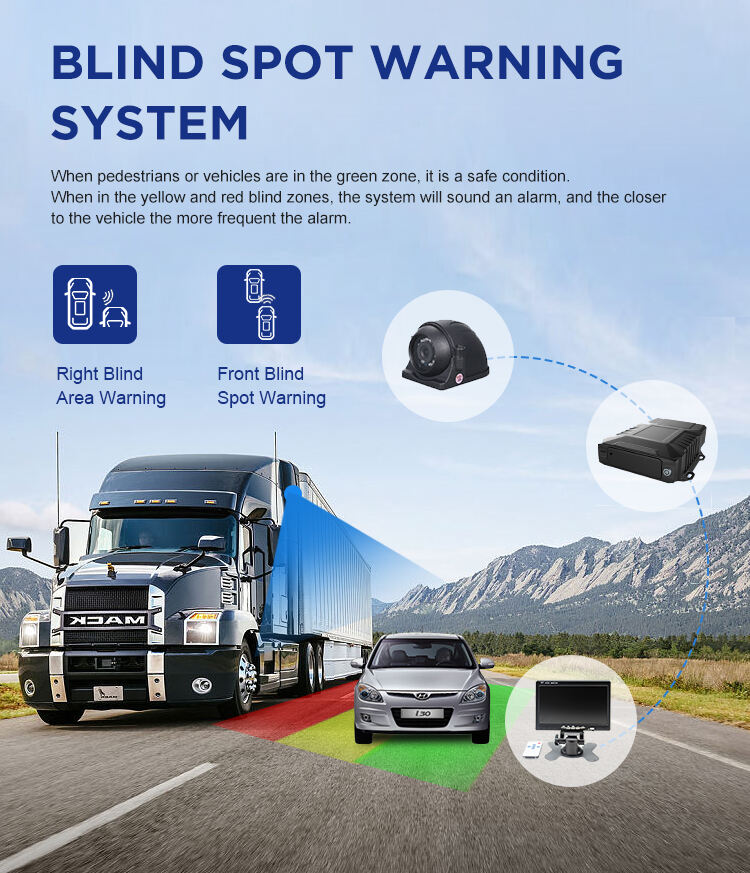The Expanding Importance Of AI Camera Systems In Fleet Safety
The role of AI Camera technology in fleet operations is no longer limited to recording evidence after accidents. Modern fleets demand solutions that provide real-time monitoring, advanced analytics, and proactive alerts. AI Camera systems combine multiple intelligent features, including ADAS, DMS, BSD, license plate recognition, and even facial recognition, to create a comprehensive safety net for drivers and managers. Instead of relying on traditional surveillance methods, fleets now benefit from AI Camera solutions that predict risks, enhance decision-making, and ensure compliance with regulatory standards. As transportation becomes more complex, the ability of AI Camera technology to evolve with fleet safety demands is becoming one of the most critical factors for long-term operational success.
Evolution Of AI Camera Technology
From Passive Recording To Intelligent Monitoring
In the past, video recorders acted as silent witnesses, providing footage only when incidents occurred. While this was useful for investigations, it did little to prevent accidents. The introduction of AI Camera systems marked a turning point by enabling real-time driver monitoring, road condition assessment, and immediate safety interventions. Fleets shifted from reactive responses to proactive prevention.
Expansion Of AI-Powered Features
AI Camera technology expanded its scope with functions like ADAS, which detects lane departure, forward collision risks, and unsafe following distances. DMS added another layer by tracking driver fatigue and distraction. BSD ensured blind spot awareness, reducing the risk of side collisions. Together, these advancements transformed fleet safety from basic observation to comprehensive protection.
Adaptability To Industry Demands
One of the defining traits of AI Camera systems is adaptability. Through continuous software updates and algorithmic enhancements, AI Cameras improve their accuracy, reduce false alerts, and adjust to unique driving environments. This ability to evolve ensures that fleets can meet changing safety regulations and rising customer expectations.
Safety Benefits Of AI Camera Integration
Preventing Fatigue-Related Accidents
Driver fatigue remains one of the most dangerous challenges in transportation. AI Camera systems equipped with DMS track eyelid movements, yawning, and head positioning, issuing instant alerts when drowsiness is detected. This proactive warning gives drivers the opportunity to take breaks before accidents occur.
Minimizing Distracted Driving
Distraction is a common cause of road incidents. AI Camera solutions monitor eye gaze, hand activity, and head position. If a driver uses a mobile phone or looks away from the road for extended periods, the system intervenes with audible alerts, reducing risks caused by inattention.
Enhancing Awareness Of Blind Spots
BSD-enabled AI Camera systems reduce the dangers of vehicles entering blind spots. By constantly monitoring side and rear zones, the system alerts drivers when lane changes or turns could lead to collisions. This function is especially critical for large trucks navigating narrow roads.

Operational Value Of AI Camera Systems
Reducing Costs And Liability
Every avoided collision saves fleets from repair costs, insurance claims, and potential lawsuits. AI Camera technology not only lowers operational risks but also provides documented evidence that protects companies in case of disputes. The combination of ADAS, BSD, and DMS makes these savings even more significant.
Supporting Driver Training And Coaching
AI Camera footage provides managers with detailed examples of risky behavior and safe practices. This real-world evidence supports targeted coaching programs, helping drivers understand how to correct mistakes. Over time, training supported by AI Camera data leads to improved driver performance and reduced accident frequency.
Improving Fleet Efficiency And Trust
Clients and regulators place high importance on safety standards. Fleets that deploy AI Camera systems demonstrate responsibility, gaining customer trust and industry credibility. Reliable safety measures not only protect people but also strengthen relationships with clients who prioritize reliability in logistics.
Cloud Connectivity And Data Sharing
Today’s AI Camera platforms already leverage cloud infrastructure for seamless integration across entire fleets. This enables centralized safety management, live data sharing, and predictive analytics that improve not only safety but also route efficiency and fuel management.
Technological Advancements Of AI Camera
Advanced Driver Assistance Systems (ADAS)
ADAS-enabled AI Camera systems have become essential tools for reducing collisions. By monitoring vehicle speed, lane positioning, and road conditions, they provide early warnings for unsafe driving. Real-time collision alerts and lane departure warnings turn every AI Camera into a co-pilot that enhances driver awareness.
Driver Monitoring Systems (DMS)
DMS integration makes AI Camera systems capable of understanding driver states. By analyzing facial expressions, head movement, and even eye activity, DMS detects fatigue and distraction before they lead to dangerous outcomes. This safety layer adds accountability and protection to every journey.
Blind Spot Detection (BSD)
BSD extends driver awareness to areas that are otherwise invisible. AI Camera systems continuously monitor blind spots and alert drivers when overtaking vehicles or objects present risks. In urban delivery and highway trucking, this function significantly reduces side collisions.
License Plate And Facial Recognition
Modern AI Camera technology is not limited to detecting fatigue or road hazards. License plate recognition enables fleet operators to track vehicles, verify access, and enhance security. Facial recognition ensures driver identification, preventing unauthorized usage and supporting accountability within fleet management.
Future Development Of AI Camera Technology
Predictive Safety Intelligence
The next step for AI Camera systems is predictive intelligence. By analyzing past driver performance, biometric signals, and environmental conditions, cameras may soon predict risks before they even arise. This shift would transform fleet safety from real-time alerts to proactive, predictive strategies.
Integration With Autonomous Driving
As autonomous and semi-autonomous vehicles enter the fleet market, AI Camera technology will remain central. Even in vehicles with advanced automation, human oversight is essential. AI Camera systems ensure that drivers remain alert and ready to take control when required, bridging the gap between automation and human responsibility.
Organizational Impact Of AI Camera Systems
Creating A Culture Of Safety
The presence of AI Camera technology encourages drivers to adopt safer behaviors. Over time, proactive monitoring shapes a culture where safety is prioritized, reducing the likelihood of risky driving becoming routine.
Promoting Transparency And Accountability
AI Camera systems provide unbiased data that supports fair decision-making. When disputes arise, video evidence ensures that managers and drivers rely on facts rather than assumptions, fostering mutual trust within the organization.
Retaining And Motivating Drivers
Drivers who feel supported by safety technology are more likely to stay with their companies. AI Camera solutions demonstrate that fleets value driver well-being, increasing job satisfaction and reducing turnover rates in an industry often challenged by workforce shortages.
FAQ
How do AI Camera systems improve fleet safety
AI Camera systems combine ADAS, DMS, BSD, license plate recognition, and facial recognition to prevent accidents, monitor driver behavior, and ensure vehicles operate under safe conditions.
Can AI Camera technology lower costs for fleet operators
Yes, AI Camera solutions reduce expenses by preventing accidents, providing evidence for insurance claims, and supporting efficient driver training programs.
Do AI Camera systems integrate with other technologies
AI Camera systems integrate with fleet management software, telematics, and cloud platforms, creating a connected ecosystem that improves safety, compliance, and operational efficiency.
Will drivers accept the use of AI Camera monitoring
While initial hesitation may occur, drivers generally recognize the benefits over time. They see AI Camera systems as tools for protection rather than surveillance, especially when alerts prevent accidents and enhance their safety.
Table of Contents
- The Expanding Importance Of AI Camera Systems In Fleet Safety
- Evolution Of AI Camera Technology
- Safety Benefits Of AI Camera Integration
- Operational Value Of AI Camera Systems
- Technological Advancements Of AI Camera
- Future Development Of AI Camera Technology
- Organizational Impact Of AI Camera Systems
- FAQ


